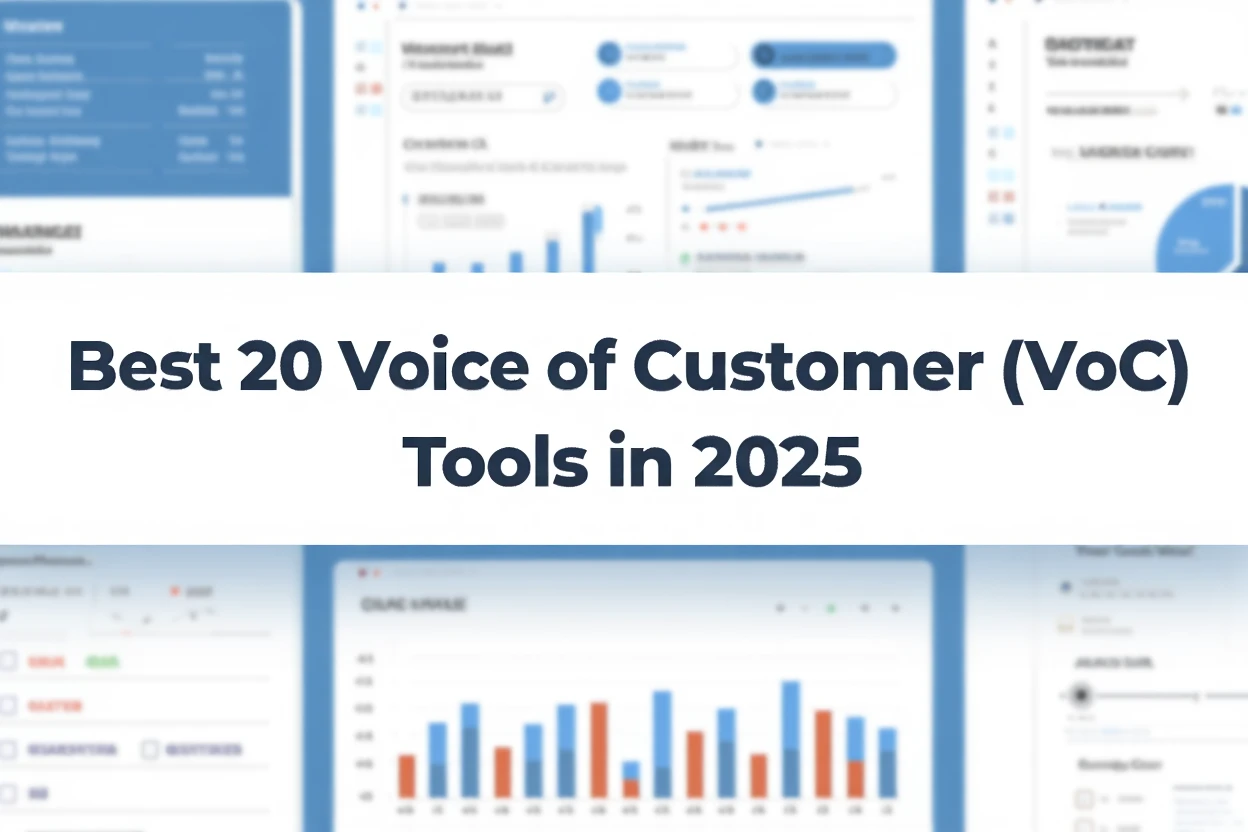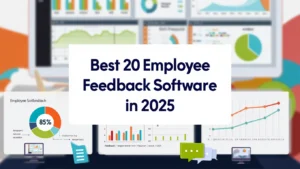Every business claims to listen to its customers, but without the right Voice of Customer (VoC) tools, valuable insights slip through the cracks. Research shows that 94% of customers are more likely to be loyal to a brand that listens to feedback, while companies using VoC programs grow revenue 10x faster.
That’s why we tested, researched, and reviewed dozens of VoC platforms to bring you the top 20 tools of 2025.
This list is designed for agencies, eCommerce store owners, SaaS businesses, and enterprise teams who want to measure customer sentiment, collect feedback at scale, and act on it without wasting resources.
Whether you’re looking for VoC software for surveys, feedback analytics, or AI-driven sentiment tracking, this guide breaks down everything you need.
What is Voice of Customer (VoC)?
VoC is a structured approach to capturing what customers say about your business across touchpoints—reviews, surveys, social media, live chat, and more.
VoC tools help you:
- Collect customer feedback at scale.
- Analyze sentiment and recurring themes.
- Prioritize improvements based on customer needs.
- Strengthen loyalty and reduce churn.
For businesses, VoC is not just “nice to have.” It’s a revenue driver. Brands that excel in customer experience see 5.7x more revenue than those that don’t (Temkin Group).
Quick Comparison of Top 20 VoC Tools (2025)
When choosing a Voice of Customer tool, decision-makers care about pricing, ease of use, integrations, and unique features. Below is a comparison table with the most relevant buying factors.
These metrics matter because they answer the biggest buyer questions upfront: affordability, accessibility, and what makes each tool stand out.
| Tool Name | Best For | Starting Price | Free Trial? | Key Feature | Rating |
| Qualtrics | Enterprise VoC programs | $150/mo | Yes | AI-driven sentiment | 4.8 |
| Medallia | CX-focused enterprises | Custom | No | Omnichannel feedback | 4.7 |
| SurveyMonkey | SMBs & freelancers | $25/mo | Yes | Easy survey creation | 4.6 |
| Typeform | Interactive surveys | $29/mo | Yes | Conversational forms | 4.5 |
| InMoment | Customer journey analytics | Custom | No | Predictive analytics | 4.7 |
| GetFeedback | Salesforce users | $25/mo | Yes | Native CRM integration | 4.6 |
| Feedier | Gamified feedback | $40/mo | Yes | Incentivized surveys | 4.4 |
| NICE Satmetrix | NPS measurement | $30/mo | Yes | Benchmarking insights | 4.5 |
| AskNicely | Service-based teams | $39/mo | Yes | Real-time NPS tracking | 4.5 |
| Hotjar | Website experience | $39/mo | Yes | Heatmaps & surveys | 4.6 |
| Usabilla (SurveyMonkey Enterprise) | Digital teams | Custom | No | In-app surveys | 4.4 |
| Clarabridge | AI-powered VoC analytics | Custom | No | Text & speech analysis | 4.7 |
| Alchemer (SurveyGizmo) | Mid-sized businesses | $49/mo | Yes | Custom workflows | 4.6 |
| Yotpo | eCommerce reviews | $19/mo | Yes | Review management | 4.5 |
| Podium | Local businesses | $249/mo | Yes | Review collection | 4.6 |
| Birdeye | Multi-location businesses | $299/mo | Yes | Reputation management | 4.7 |
| Reputation.com | Large organizations | Custom | No | Centralized feedback | 4.6 |
| Survicate | SaaS & startups | $89/mo | Yes | Website intercepts | 4.5 |
| Mopinion | Digital channels | $229/mo | Yes | On-site feedback | 4.4 |
| CustomerGauge | B2B enterprises | Custom | No | Account-level feedback | 4.6 |
Best VoC Tools in 2025
Below, we break down the top 20 Voice of Customer tools one by one. You’ll see detailed reviews, pricing, pros & cons, and who each tool is best for.
1. Qualtrics – Enterprise-Grade Voice of Customer Platform
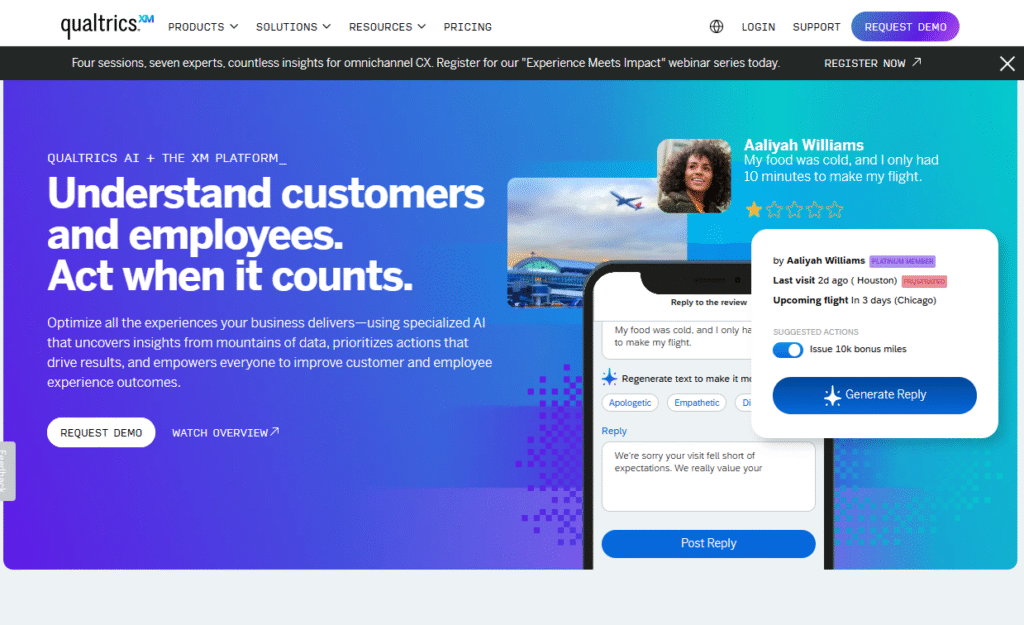
Qualtrics is one of the most established VoC tools, widely adopted by enterprises that need large-scale survey distribution, AI-powered sentiment analysis, and integration across multiple business units. Brands like Microsoft, BMW, and JetBlue rely on Qualtrics for its advanced customer experience management features. If you’re considering a Qualtrics review, you’ll find it excels in analytics depth but requires an investment in both budget and onboarding.
Key Features
AI-Driven Sentiment Analysis
Qualtrics uses natural language processing (NLP) to analyze open-ended feedback, reviews, and survey responses at scale. This feature matters because it saves hours of manual analysis and provides executives with real-time insights into customer sentiment trends.
Omnichannel Feedback Collection
With Qualtrics, businesses can capture customer feedback across email, SMS, websites, apps, and even voice. This breadth ensures you’re not missing input from critical touchpoints, making it one of the most comprehensive VoC solutions.
Advanced Reporting & Dashboards
Customizable dashboards allow managers and executives to track Net Promoter Score (NPS), Customer Satisfaction (CSAT), and Customer Effort Score (CES) in real-time. The level of detail is a standout when compared to tools like Medallia or InMoment.
Enterprise Integrations
Qualtrics connects natively with platforms like Salesforce, SAP, and Slack. This is vital for teams that want VoC insights to feed directly into workflows without disrupting existing tech stacks.
Predictive Analytics
By leveraging AI, Qualtrics predicts customer churn risk and identifies potential upsell opportunities. For enterprises managing thousands of accounts, this feature can directly translate into revenue retention.
Pros & Cons
| Pros | Cons |
| Powerful analytics & reporting | Expensive compared to SMB tools |
| Scalable for global enterprises | Steeper learning curve |
| Strong integration ecosystem | Custom pricing can be confusing |
| Trusted by Fortune 500 brands | Requires dedicated onboarding |
| AI-powered predictive models | May be overkill for small teams |
Pricing
Qualtrics pricing starts at around $150/month for small teams, but most enterprise implementations are custom-quoted. It’s not the cheapest option, but its depth justifies the cost for organizations with complex VoC needs.
Best For Large Enterprises Managing Multi-Channel Feedback
Qualtrics is best suited for:
- Enterprise CX Teams — needing deep analytics across millions of feedback points.
- Global Brands — requiring multi-language support and compliance features.
- Salesforce/SAP Users — who want seamless CRM integrations.
- Data-Driven Marketers — aiming to predict churn and retention patterns.
- Executives — looking for advanced reporting for board-level insights.
Use Qualtrics’ predictive churn analysis not just for retention but also for upselling. Many teams overlook that it can flag accounts ready for expansion, not just at-risk ones.
How to Use Qualtrics for Local Customer Feedback
If you’re running a multi-location business, set up separate dashboards for each branch or region. This lets you compare satisfaction scores by geography and act faster on local issues before they damage brand-wide reputation.
Best Alternate Tool
If Qualtrics feels too expensive or complex, Medallia is the closest competitor. It offers similar enterprise-grade analytics but with a stronger focus on customer journey mapping.
2. Medallia – Customer Experience Intelligence for Enterprises
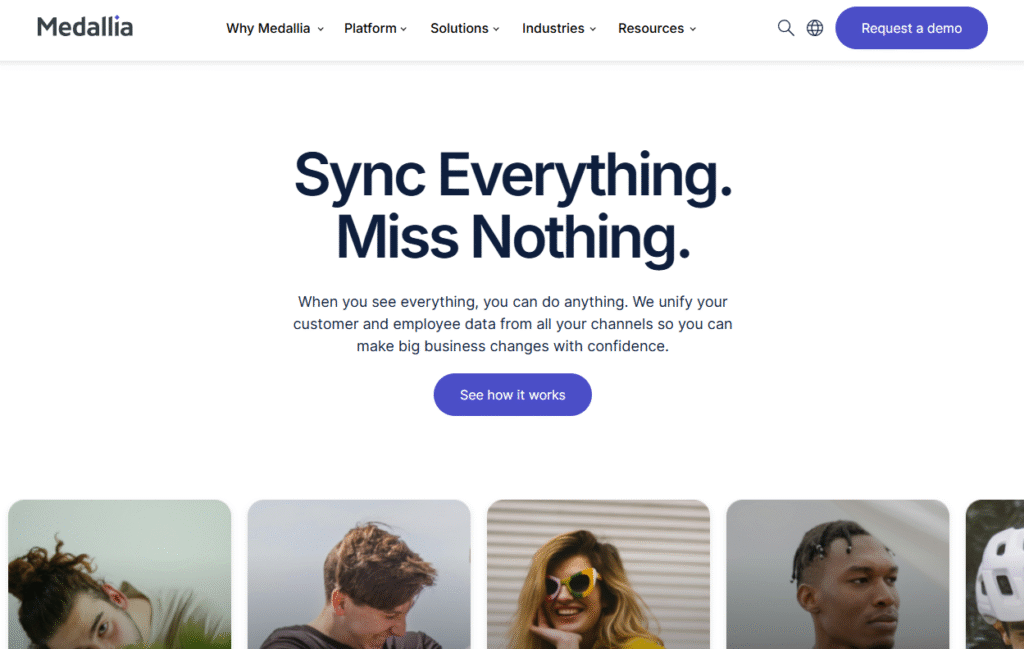
Medallia is a leader in the VoC software space, particularly strong in customer journey mapping and omnichannel experience tracking. Known for powering feedback programs at companies like Hilton, Delta Airlines, and Samsung, Medallia is often compared head-to-head in Medallia vs Qualtrics discussions. Where it shines is in giving enterprises a 360° view of customer interactions across digital, retail, and support channels.
Key Features
Omnichannel Feedback Collection
Medallia captures customer signals from email, web, social media, mobile apps, call centers, and in-store kiosks. This unified approach ensures that no feedback channel is overlooked, making it indispensable for enterprises with diverse customer touchpoints.
Real-Time Alerts & Action Management
Unlike many survey-first platforms, Medallia sends instant alerts to frontline employees when feedback indicates a potential churn risk or service issue. This helps teams act quickly rather than waiting for quarterly reviews.
AI-Powered Text & Speech Analytics
Medallia’s analytics engine goes beyond text surveys. It also processes call transcripts, reviews, and social posts, identifying themes and sentiment trends with remarkable accuracy. This is crucial for businesses with heavy call center operations.
Customer Journey Mapping
One of Medallia’s signature features is its ability to visualize the entire customer journey. By mapping feedback at each stage, companies can pinpoint bottlenecks, whether in checkout processes, onboarding, or support escalations.
Benchmarking & Industry Data
Medallia offers access to industry benchmarks, allowing businesses to compare their CX performance against competitors. This adds a layer of strategic intelligence not found in simpler VoC platforms.
Pros & Cons
| Pros | Cons |
| Excellent for large enterprises | Pricing is opaque (custom quotes) |
| Customer journey mapping is robust | Complex setup and onboarding |
| Real-time feedback alerts | Limited appeal for SMBs |
| Strong text & speech analytics | Steeper learning curve |
| Wide industry adoption | Some features locked behind higher tiers |
Pricing
Medallia operates on a custom pricing model, often quoted in enterprise contracts. While not publicly listed, most mid-to-large companies budget five to six figures annually for a full Medallia rollout.
Best For Enterprises Focused on Customer Journeys
Medallia is best suited for:
- Travel & Hospitality Brands — to capture customer experience across physical and digital channels.
- Telecoms & Call Centers — that need speech analytics and instant escalation alerts.
- Retail Chains — managing feedback across hundreds of stores.
- Global Enterprises — requiring multi-language, multi-region support.
- Executives — who need benchmarking against industry peers.
Use Medallia’s real-time feedback alerts to connect directly with frontline staff. Closing the loop immediately after a negative review can turn detractors into promoters faster than delayed follow-ups.
How to Use Medallia for Employee Experience
Medallia isn’t just for customers—it also has an Employee Experience module. By measuring employee sentiment alongside customer sentiment, businesses can find correlations between team morale and CX outcomes.
Best Alternate Tool
If you’re considering alternatives, InMoment is a strong competitor to Medallia. It provides similar customer journey insights but leans more heavily into predictive analytics and AI forecasting.
3. SurveyMonkey – Accessible VoC Surveys for SMBs

SurveyMonkey (now part of Momentive) is one of the most recognizable names in online surveys. Unlike enterprise-heavy platforms such as Qualtrics or Medallia, SurveyMonkey focuses on making customer feedback collection simple, fast, and affordable. If you’re researching a SurveyMonkey review, you’ll find it is widely used by startups, small businesses, and marketing teams that want professional-grade survey tools without complex onboarding.
Key Features
Easy-to-Use Survey Builder
SurveyMonkey’s drag-and-drop interface allows even non-technical users to create surveys in minutes. Pre-built templates for NPS, CSAT, and customer feedback speed up the process, ensuring businesses can launch VoC campaigns quickly.
Wide Question Variety
Beyond standard multiple-choice questions, SurveyMonkey offers Likert scales, star ratings, open text, and even image-based questions. This flexibility helps businesses design surveys that match their audience and goals.
Automated Survey Distribution
Surveys can be sent via email, embedded on websites, shared through social media, or integrated directly into apps. This multi-channel approach ensures customers can provide feedback wherever they are most comfortable.
Analytics & Benchmarking
SurveyMonkey includes reporting dashboards that show completion rates, sentiment breakdowns, and benchmark comparisons. Businesses can see how their results stack up against industry averages for NPS and CSAT.
Integrations with Popular Tools
SurveyMonkey connects with platforms like HubSpot, Salesforce, Mailchimp, and Slack. These integrations allow customer feedback to flow directly into CRMs and marketing platforms, eliminating data silos.
Pros & Cons
| Pros | Cons |
| Affordable and accessible | Limited advanced analytics |
| Large template library | Lacks predictive AI features |
| Great for SMBs & startups | Less suitable for large enterprises |
| Strong integrations | Customization can be limited |
| Simple to use | Free plan has strict limits |
Pricing
SurveyMonkey pricing starts at $25/month per user for basic plans, while Team Advantage and Team Premier plans range from $25 to $75 per user per month. Enterprise plans are available for larger organizations.
Best For SMBs and Fast Feedback Collection
SurveyMonkey is best suited for:
- Small Businesses — needing affordable customer surveys.
- Marketing Teams — who want quick insights for campaigns.
- Startups — looking to validate product-market fit through customer input.
- Nonprofits & Education — using surveys for feedback at scale.
- Agencies — managing multiple client accounts with separate surveys.
Use SurveyMonkey’s survey logic and branching to personalize the survey flow. This ensures respondents only see questions relevant to them, which improves completion rates.
How to Use SurveyMonkey for NPS Tracking
Set up recurring Net Promoter Score (NPS) surveys with automated scheduling. Over time, you’ll be able to track trends and correlate customer loyalty with business performance.
Best Alternate Tool
If you need a more conversational survey experience, Typeform is a great alternative to SurveyMonkey. Its interactive and engaging survey design often drives higher response rates.
4. Typeform – Conversational Surveys that Drive Engagement
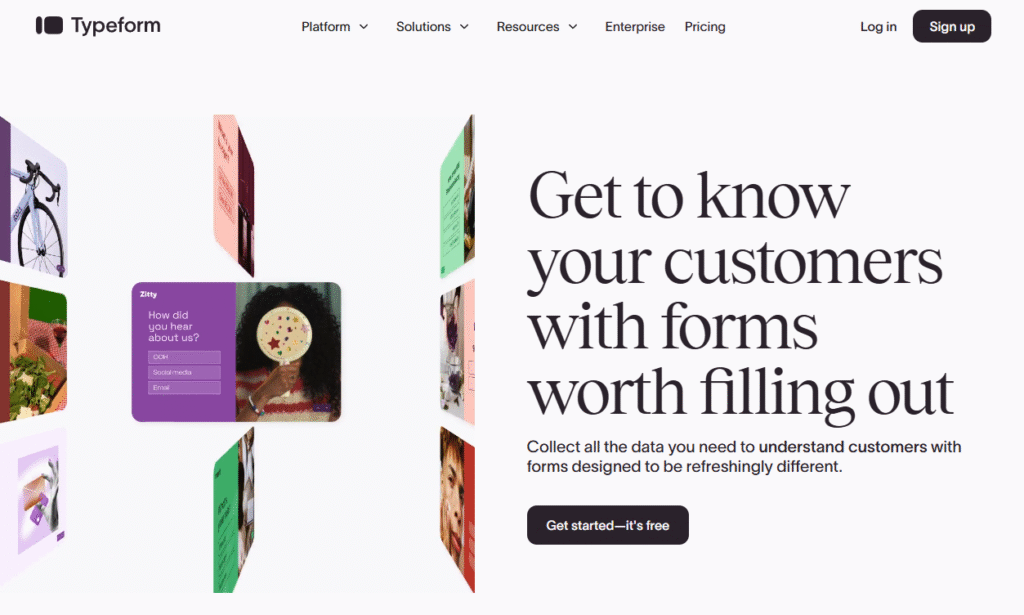
Typeform stands out in the VoC landscape because of its interactive, conversational survey style. Instead of traditional static forms, Typeform delivers one question at a time, creating a chat-like experience that feels natural to respondents. Businesses looking for higher engagement and completion rates often compare Typeform vs SurveyMonkey, with Typeform winning in terms of user experience design.
Key Features
Conversational Form Design
Typeform transforms surveys into engaging conversations. By showing one question at a time with smooth transitions, respondents feel less overwhelmed, which significantly improves completion rates compared to traditional surveys.
Custom Branding & Design Flexibility
Unlike many survey tools, Typeform allows deep customization. Businesses can add logos, brand colors, and background images, ensuring surveys align perfectly with their branding. This makes it particularly attractive for consumer-facing businesses.
Logic Jumps for Personalization
Typeform’s logic jumps let you personalize survey flows based on responses. For example, if a customer gives a low satisfaction rating, you can route them to follow-up questions to learn more about their issue.
Integrations with 120+ Tools
Typeform integrates seamlessly with HubSpot, Zapier, Google Sheets, Notion, and Slack. This ensures customer responses flow directly into business workflows without manual exporting.
Advanced Analytics
Typeform’s dashboard provides real-time reporting, completion tracking, and drop-off analysis. This helps teams identify which questions cause friction and optimize surveys for better results.
Pros & Cons
| Pros | Cons |
| Highly engaging survey design | More expensive than basic survey tools |
| Strong branding and customization | Limited enterprise-level analytics |
| Excellent for customer-facing surveys | Requires integrations for deeper insights |
| Logic jumps personalize experiences | Free plan has restrictions |
| Broad integration ecosystem | Not ideal for heavy statistical analysis |
Pricing
Typeform pricing starts at $29/month for the Basic plan, with Plus and Business plans at $59/month and $99/month. Larger enterprises can request custom pricing.
Best For Businesses Focused on Engagement
Typeform is best suited for:
- Consumer Brands — that want visually appealing surveys.
- Marketers — aiming to increase survey response rates.
- Agencies — designing branded client feedback forms.
- Product Teams — collecting feedback during product testing.
- HR Teams — running employee engagement surveys.
Use Typeform for post-purchase feedback. Embedding short surveys on order confirmation pages or in follow-up emails yields higher response rates compared to traditional survey links.
How to Use Typeform for Customer Onboarding Feedback
Create an onboarding survey that triggers automatically after new customers sign up. This helps capture first impressions and identify friction points before churn risk increases.
Best Alternate Tool
If you’re looking for more advanced analytics but still want simple survey creation, Alchemer (formerly SurveyGizmo) is a solid alternative. It combines flexibility with stronger reporting capabilities.
5. InMoment – Predictive Customer Experience Analytics
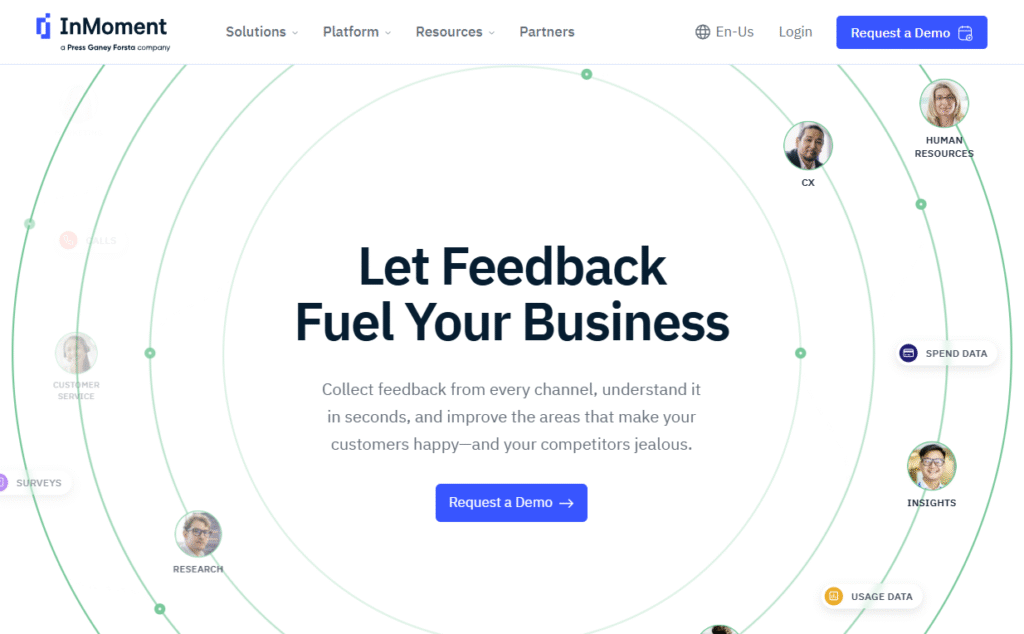
InMoment is a powerful VoC tool designed for businesses that want to go beyond basic surveys and dive into customer journey intelligence. It’s often highlighted in InMoment reviews for its predictive analytics, real-time reporting, and focus on uncovering actionable insights from customer feedback. Many enterprises choose InMoment when comparing InMoment vs Medallia, especially for its AI-driven forecasting capabilities.
Key Features
Predictive Analytics
InMoment leverages AI to forecast customer behavior based on historical feedback. This helps businesses identify potential churn risks or upsell opportunities before they happen, making it a proactive VoC solution.
Experience Intelligence (XI) Platform
The XI platform consolidates data from surveys, social media, call centers, and CRM systems. This unified approach ensures decision-makers see a holistic view of the customer experience rather than fragmented insights.
Text & Sentiment Analysis
InMoment uses natural language processing (NLP) to analyze open-text feedback. It automatically tags and categorizes themes, enabling teams to identify recurring customer pain points and emerging trends at scale.
Real-Time Dashboards
Executives and frontline teams can access live dashboards customised to their roles. This allows CX leaders to see big-picture trends while customer support teams get instant alerts for urgent feedback.
Action Planning Tools
Beyond data collection, InMoment includes workflows to assign tasks, track resolution progress, and ensure customer issues are closed out effectively. This makes feedback more actionable than static reporting tools.
Pros & Cons
| Pros | Cons |
| Strong predictive analytics | Pricing is enterprise-focused |
| Centralized feedback intelligence | Steeper onboarding process |
| Great for customer journey analysis | Not ideal for small businesses |
| AI-powered sentiment tagging | Limited flexibility in lower tiers |
| Strong reporting customization | Fewer templates compared to survey-first tools |
Pricing
InMoment follows a custom pricing model, primarily catering to mid-market and enterprise businesses. Costs depend on scale, integrations, and the number of customer touchpoints being tracked.
Best For Enterprises Wanting Predictive Insights
InMoment is best suited for:
- SaaS Companies — predicting churn before it happens.
- Financial Services — analyzing sentiment from calls, surveys, and chats.
- Retail & eCommerce Brands — optimizing customer journeys from discovery to purchase.
- Telecoms — managing large call volumes and sentiment trends.
- CX Leaders — who want data visualization and action planning in one tool.
Use InMoment’s predictive churn analytics to proactively reach out to at-risk accounts with retention offers before they cancel. Many companies see measurable improvements in lifetime value this way.
How to Use InMoment for Multi-Channel Analysis
Set up integrations with both CRM and call center systems. This enables the platform to pull structured (survey scores) and unstructured (call transcripts, chat logs) data into a single view for deeper analysis.
Best Alternate Tool
If you’re weighing alternatives, Clarabridge is a strong option. It specializes in text and speech analytics with advanced AI classification, making it a competitor worth considering for enterprises prioritizing sentiment analysis.
6. GetFeedback – Salesforce-Native VoC Platform
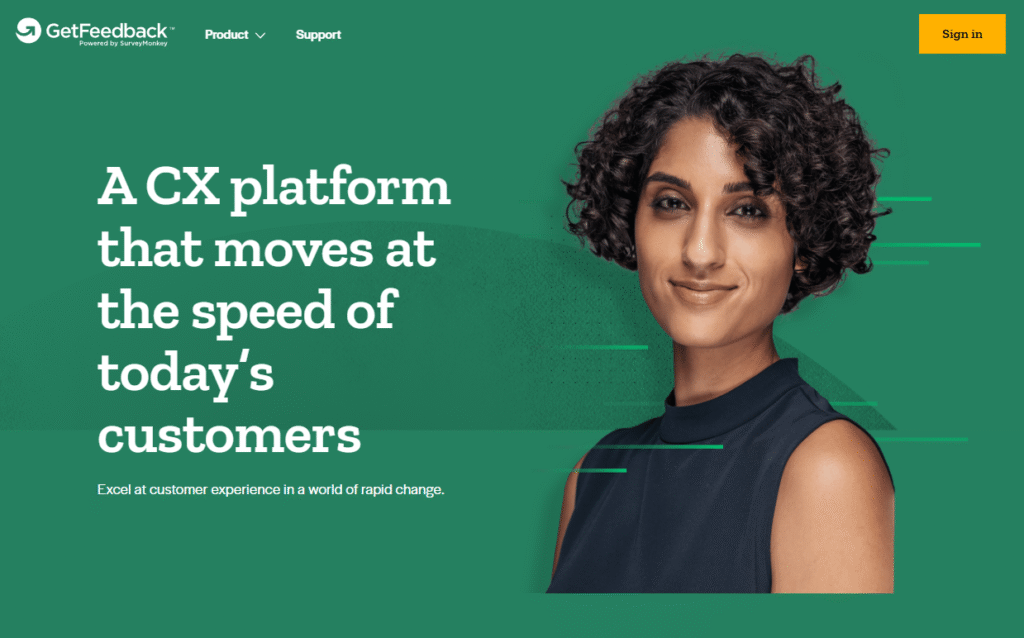
GetFeedback is a VoC tool built with Salesforce users in mind. Its biggest advantage is how seamlessly it integrates with Salesforce CRM, making it the go-to solution for teams already invested in the Salesforce ecosystem. In GetFeedback reviews, businesses often highlight how quickly they can launch branded surveys and how the platform connects feedback directly to customer records.
Key Features
Salesforce Integration
GetFeedback’s native Salesforce integration ensures every response is tied to the right customer record. This means sales and service teams can immediately act on feedback without switching platforms.
Branded, Mobile-Friendly Surveys
Surveys are optimized for mobile-first experiences and can be customized with company branding. This is especially useful for businesses engaging customers through mobile channels.
Real-Time Dashboards
Data flows instantly into Salesforce dashboards. Managers can view live NPS, CSAT, and CES scores while setting alerts for feedback that requires immediate follow-up.
Multi-Channel Feedback Collection
Surveys can be distributed through email, websites, SMS, or embedded in apps. The flexibility ensures customers can respond on their preferred channel.
Automation & Workflows
Responses can trigger automated workflows inside Salesforce, such as creating a case for customer service or notifying an account manager about a dissatisfied client.
Pros & Cons
| Pros | Cons |
| Best VoC tool for Salesforce users | Limited use outside Salesforce |
| Branded surveys look professional | Fewer advanced analytics than enterprise tools |
| Easy mobile survey deployment | Not ideal for very large enterprises |
| Automated workflows save time | Custom pricing can be unclear |
| Strong real-time reporting | Smaller template library compared to SurveyMonkey |
Pricing
GetFeedback pricing starts at $25/month for basic survey creation. However, for Salesforce-native functionality and advanced VoC programs, pricing is custom-quoted depending on organization size and use case.
Best For Salesforce-Centric Organizations
GetFeedback is best suited for:
- Sales Teams — tying feedback directly to pipeline deals.
- Customer Success Teams — tracking satisfaction across accounts.
- Support Teams — automating case creation from feedback.
- Marketers — embedding surveys at critical customer journey stages.
- CX Leaders — who want data flowing natively into Salesforce dashboards.
Use GetFeedback’s workflow automation to escalate negative responses immediately to account managers. Quick intervention can often turn detractors into promoters.
How to Use GetFeedback for Customer Success
Set up recurring NPS surveys linked to Salesforce contacts. When scores drop below a threshold, automate case creation for your customer success team to follow up.
Best Alternate Tool
If you don’t use Salesforce but still want strong integrations, Survicate is a better alternative. It offers flexible survey options with native integrations to HubSpot, Intercom, and other CRMs.
7. Feedier – Gamified Feedback Collection
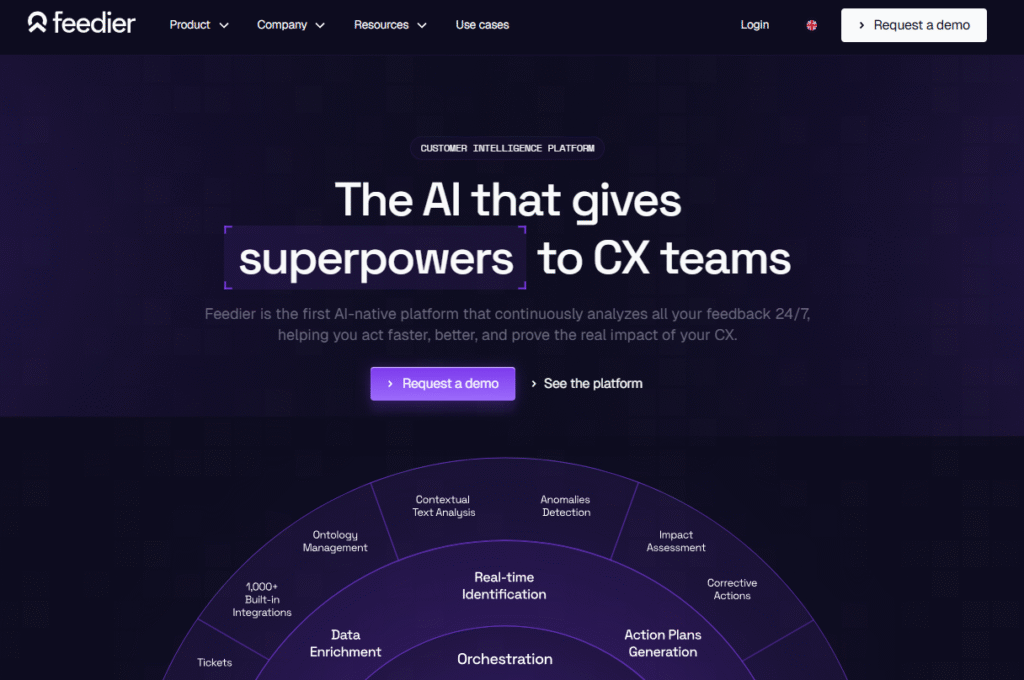
Feedier takes a unique approach to VoC by gamifying the feedback process. Instead of relying solely on traditional surveys, it turns feedback collection into an interactive experience that rewards customers for participating. Many Feedier reviews emphasize how this approach increases response rates and customer engagement, making it an attractive alternative for businesses struggling with survey fatigue.
Key Features
Gamified Feedback System
Feedier motivates customers by offering rewards like coupons, vouchers, or discounts for completing surveys. This element of fun and value exchange boosts participation rates significantly.
Multi-Channel Feedback
Businesses can collect feedback through email, QR codes, websites, and mobile apps. The platform ensures accessibility regardless of how customers prefer to interact.
Advanced Analytics
Feedier doesn’t just collect responses—it helps you categorize and analyze them using tags, KPIs, and sentiment analysis. This allows businesses to spot recurring issues faster.
Customer Journey Tracking
The platform provides insights across different stages of the customer journey, helping businesses understand which touchpoints generate the most satisfaction—or frustration.
API & Integrations
Feedier integrates with tools like Zapier, HubSpot, and Slack, making it easy to automate workflows and centralize feedback.
Pros & Cons
| Pros | Cons |
| Gamification improves response rates | Smaller feature set than enterprise VoC tools |
| Incentive-based surveys | Rewards may add cost |
| Easy setup and deployment | Analytics less advanced than Qualtrics |
| Multi-channel distribution | Not ideal for B2B enterprises |
| Strong for SMBs and eCommerce | Limited enterprise adoption |
Pricing
Feedier pricing starts at around $40/month, making it accessible for small to mid-sized businesses. Enterprise plans with custom features are available upon request.
Best For Businesses Needing Higher Response Rates
Feedier is best suited for:
- Ecommerce Stores — incentivizing post-purchase surveys with discount codes.
- Retail Businesses — using QR codes for in-store feedback.
- SMBs — that need affordable VoC tools with engagement hooks.
- Marketers — who want higher participation for campaign feedback.
- Agencies — running feedback campaigns for multiple clients.
Instead of offering generic rewards, tie your incentives to future purchases. This not only improves feedback participation but also drives repeat business.
How to Use Feedier for Post-Purchase Feedback
Include QR codes on packaging or receipts that link to a gamified survey. Customers are more likely to scan and participate when they know a reward is waiting.
Best Alternate Tool
If you want to drive engagement but with a more branded experience, Typeform is a strong alternative. Its conversational design increases participation without relying on incentives.
8. NICE Satmetrix – The Standard for NPS Programs
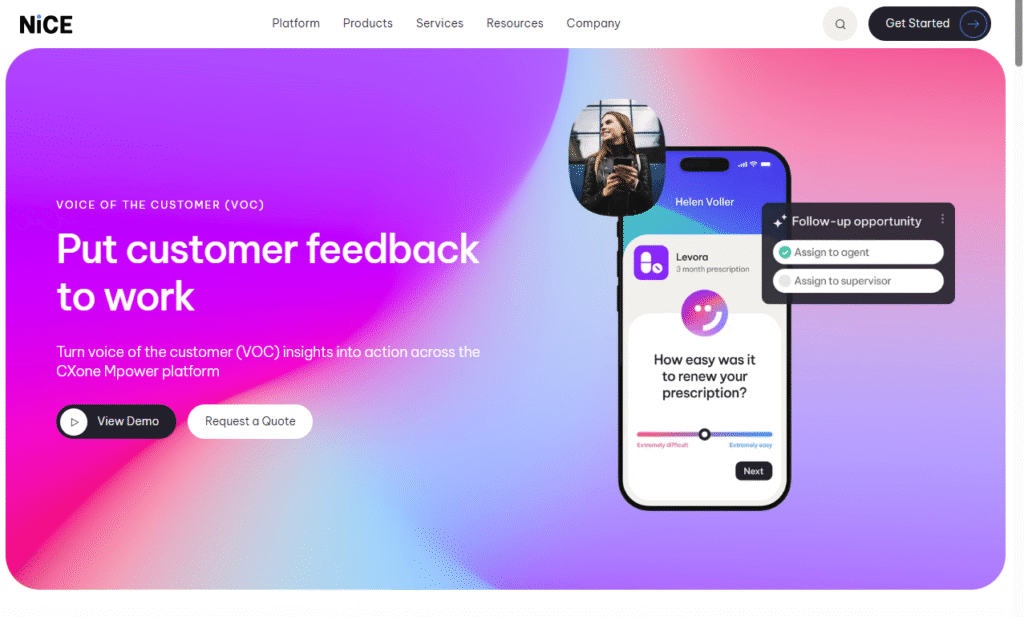
NICE Satmetrix is best known as the original co-developer of the Net Promoter Score (NPS) methodology, making it one of the most trusted names in customer experience measurement. Businesses that want a reliable VoC platform for benchmarking NPS, CSAT, and CES often compare NICE Satmetrix vs Medallia or NICE Satmetrix vs Qualtrics, with Satmetrix winning on ease of use and focus on standardized metrics.
Key Features
Net Promoter Score (NPS) Benchmarking
Since Satmetrix pioneered the NPS framework, it provides one of the most reliable benchmarking systems. Businesses can compare their scores against industry averages to assess performance objectively.
Multi-Channel Feedback Collection
The platform allows collection of customer feedback via email, web, call centers, and in-app prompts. This ensures you capture sentiment across different points in the customer journey.
Customer Experience Analytics
NICE Satmetrix provides dashboards for analyzing NPS, CSAT, and CES data. Insights are designed to highlight trends, recurring complaints, and opportunities for customer retention.
AI-Driven Sentiment Analysis
The system uses AI to interpret open-ended feedback, categorizing it into themes and sentiment categories for faster action.
Compliance & Security
As part of NICE, Satmetrix offers enterprise-level compliance and data security, making it a trusted choice for industries like banking, telecom, and healthcare.
Pros & Cons
| Pros | Cons |
| Pioneer of NPS methodology | Limited customization outside CX metrics |
| Strong benchmarking data | Lacks advanced predictive analytics |
| Easy-to-use dashboards | Pricing not transparent |
| Trusted by regulated industries | Less flexible than newer VoC tools |
| Strong compliance and security | May not fit non-enterprise SMBs |
Pricing
NICE Satmetrix pricing typically starts around $30/month per user for basic functionality, with enterprise packages requiring custom quotes.
Best For Businesses Focusing on NPS
NICE Satmetrix is best suited for:
- Enterprises — needing reliable NPS benchmarking data.
- Financial Services & Banks — requiring secure VoC platforms.
- Telecoms & Utilities — tracking CSAT and CES across call centers.
- Healthcare Providers — where compliance is critical.
- CX Leaders — prioritizing standardized customer metrics.
Use NICE Satmetrix’s benchmarking reports during quarterly reviews to show stakeholders how your CX program compares against competitors in your industry.
How to Use NICE Satmetrix for Call Centers
Integrate Satmetrix with your call center system to send automated post-call NPS surveys. This helps identify agents or teams driving higher satisfaction scores and provides coaching opportunities.
Best Alternate Tool
If you’re looking for more flexibility beyond NPS, AskNicely is a strong alternative. It focuses on real-time NPS tracking while also supporting customizable workflows.
9. AskNicely – Real-Time NPS for Service Teams
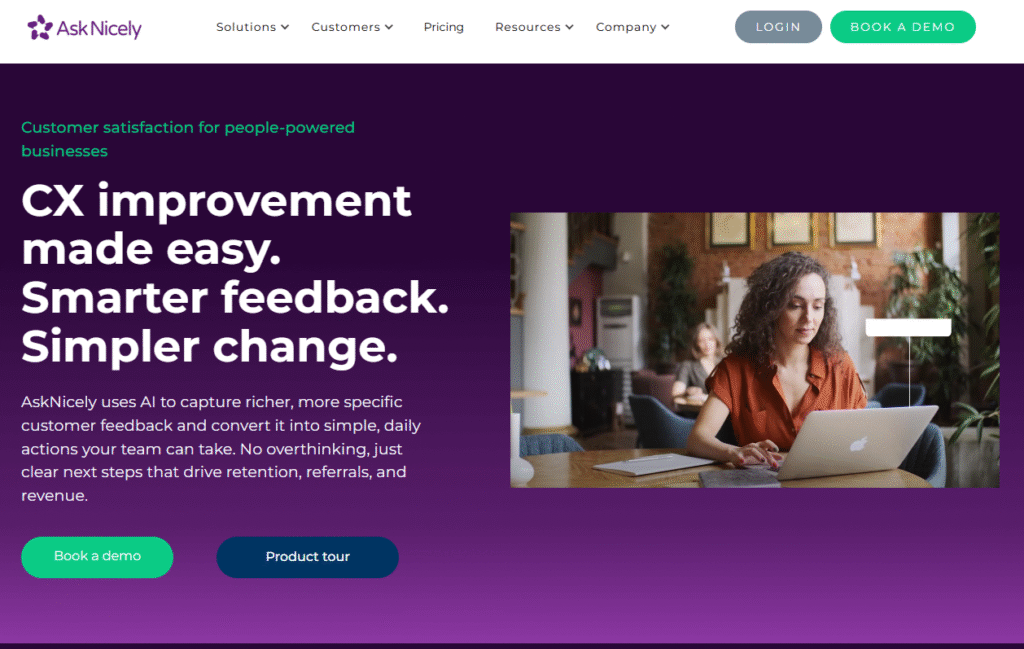
AskNicely is a VoC platform designed around the Net Promoter Score (NPS) framework but optimized for real-time feedback. Unlike enterprise-heavy tools, AskNicely is built with frontline service teams in mind, helping them collect, measure, and act on customer feedback instantly. In AskNicely reviews, users consistently highlight its simplicity, speed, and ability to motivate staff with immediate customer sentiment.
Key Features
Real-Time NPS Tracking
AskNicely captures NPS feedback continuously, giving businesses a live view of customer sentiment. This instant insight helps service teams address dissatisfaction before it escalates.
Frontline Team Engagement
The platform includes features like leaderboards, scorecards, and motivational alerts that gamify customer satisfaction for frontline employees. This ensures staff see their direct impact on customer happiness.
Automated Feedback Workflows
Negative responses can automatically trigger alerts to managers or customer success reps. This reduces response time and improves recovery for at-risk accounts.
CRM & Helpdesk Integrations
AskNicely integrates with Salesforce, HubSpot, Zendesk, and Slack, ensuring customer feedback is visible in the tools teams already use daily.
Simple Survey Distribution
Surveys can be delivered via email, SMS, or embedded in-app, making it easy to collect customer sentiment across multiple channels.
Pros & Cons
| Pros | Cons |
| Real-time NPS feedback | Narrower focus compared to full VoC suites |
| Great for frontline motivation | Limited advanced analytics |
| Strong integrations with CRMs | Not ideal for enterprises needing deep reporting |
| Easy to set up | Lacks predictive AI |
| Helps improve team accountability | Best suited for service-led industries |
Pricing
AskNicely pricing starts at $39/month per user with custom enterprise options for larger deployments.
Best For Service Teams and SMBs
AskNicely is best suited for:
- Service-Based Businesses — measuring satisfaction after customer interactions.
- Franchise Operations — tracking performance across multiple locations.
- Customer Success Teams — acting quickly on dissatisfied accounts.
- Retail & Hospitality — motivating frontline staff through feedback leaderboards.
- SMBs — that want an affordable, lightweight VoC tool.
Use AskNicely’s leaderboards to run weekly competitions among service staff. Recognizing employees with the highest customer scores boosts morale and creates a culture of CX excellence.
How to Use AskNicely for Franchise Operations
Set up separate dashboards for each franchise location. This lets franchise owners compare performance and identify which locations consistently deliver better customer experiences.
Best Alternate Tool
If you’re looking for more advanced customer journey analytics, NICE Satmetrix is a better alternative. It offers deeper insights and benchmarking while still focusing on NPS.
10. Hotjar – Website Experience & VoC Insights
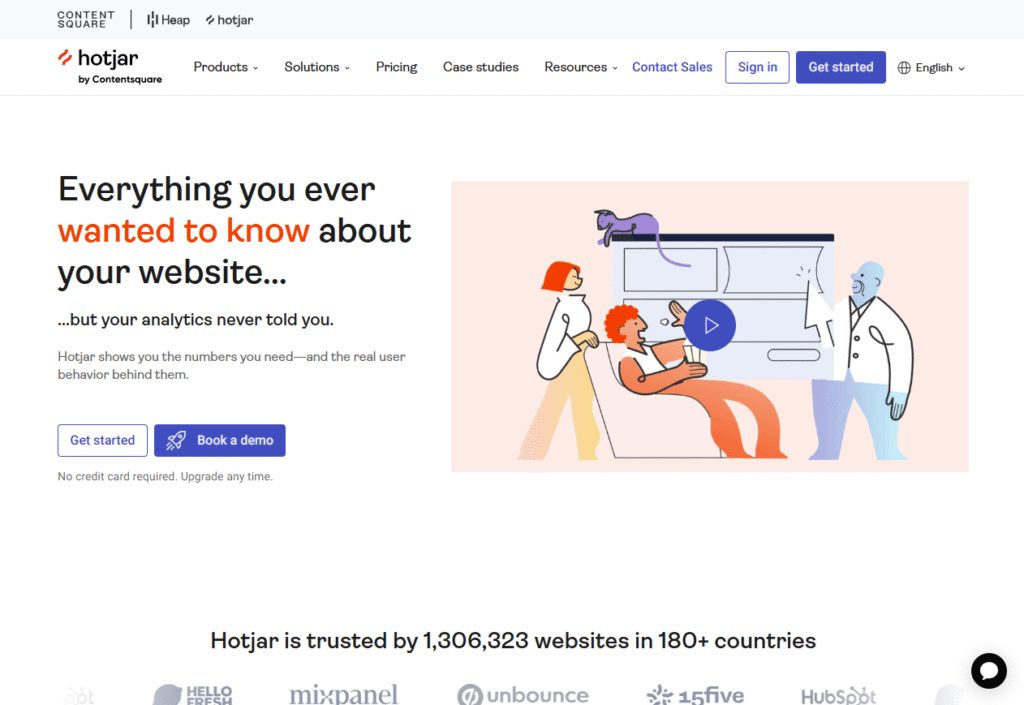
Hotjar is a VoC and customer experience platform designed specifically for websites and digital products. It goes beyond surveys by combining heatmaps, user recordings, and feedback widgets to show how customers behave online and why. When comparing Hotjar vs Qualtrics, Hotjar is far more affordable and user-friendly for SMBs and SaaS companies that want fast, visual insights into customer behavior.
Key Features
Heatmaps
Hotjar heatmaps track clicks, taps, and scroll behavior on your website. This helps businesses see where users engage most and where they drop off, which is invaluable for optimizing conversions.
Session Recordings
Watch real user sessions to understand how visitors navigate your site. By pairing this with VoC surveys, you can identify both the “what” and the “why” behind customer actions.
On-Site Feedback Widgets
Hotjar’s feedback polls and widgets let you capture real-time customer sentiment while they’re browsing. This helps address frustrations at the exact moment they occur.
Survey Tools
Hotjar includes simple survey functionality that can be deployed as pop-ups, slide-ins, or standalone forms. These can be triggered by user actions, such as exit intent or time spent on page.
Funnel Analysis
Businesses can analyze where users drop off in checkout flows or onboarding processes. This feature helps prioritize which UX issues are costing the most revenue.
Pros & Cons
| Pros | Cons |
| Combines VoC with behavioral analytics | Limited advanced VoC analytics |
| Affordable compared to enterprise tools | Surveys are basic |
| Easy to use and set up | Not designed for multi-channel feedback |
| Great for conversion optimization | Free plan has limited recordings |
| Visual insights (heatmaps, recordings) | Not suitable for large enterprises |
Pricing
Hotjar pricing starts at $39/month for the Plus plan, while the Business plan begins at $99/month. There’s also a free tier with limited surveys and recordings.
Best For Digital Experience Optimization
Hotjar is best suited for:
- Ecommerce Brands — optimizing checkout pages with heatmaps.
- SaaS Companies — analyzing user onboarding flows.
- Marketers — running on-site VoC polls alongside campaigns.
- UX Teams — understanding customer frustrations visually.
- SMBs — that want affordable VoC and UX insights in one tool.
Use Hotjar’s exit-intent surveys to ask visitors why they’re leaving before completing a purchase. The insights often highlight friction points you can fix immediately.
How to Use Hotjar for Product Feedback
Deploy a feedback widget inside your SaaS app to capture suggestions from active users. This helps product managers prioritize features based on what customers actually request.
Best Alternate Tool
If you want more advanced VoC analytics combined with journey mapping, InMoment is a strong alternative. It provides predictive insights that go beyond what Hotjar offers.
11. Usabilla (SurveyMonkey Enterprise) – In-App & Website Feedback
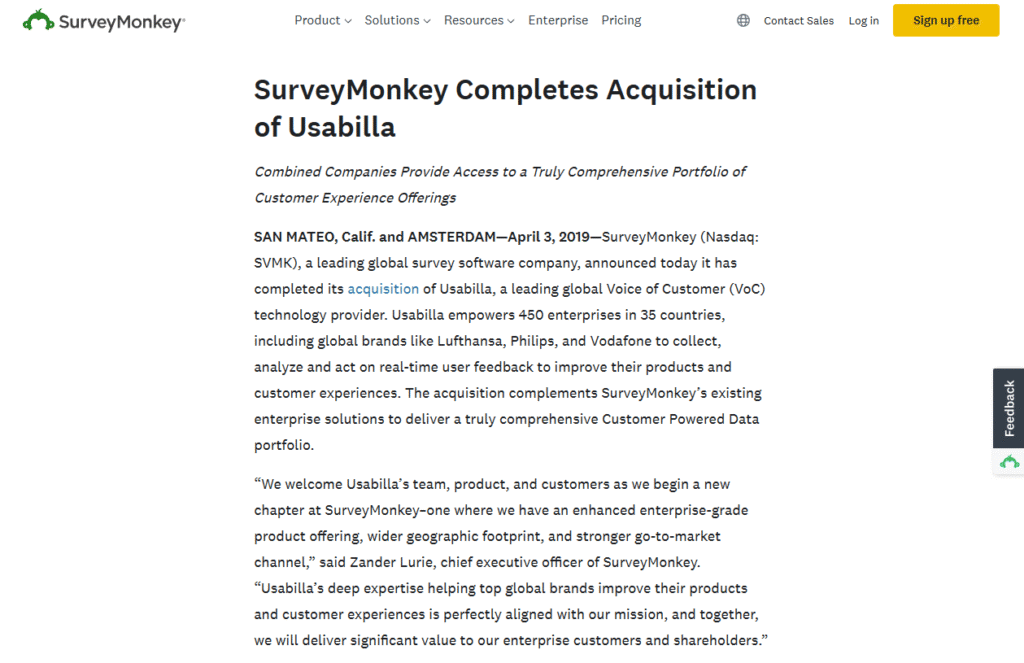
Usabilla, now part of SurveyMonkey Enterprise, is a VoC tool built for capturing real-time feedback within digital experiences. It’s designed for product teams, marketers, and UX specialists who want to collect insights directly from users as they interact with websites, apps, or digital campaigns. Many Usabilla reviews highlight its ability to uncover friction points during live customer sessions, making it an excellent choice for digital-first organizations.
Key Features
In-App & Website Feedback Widgets
Usabilla places widgets and buttons on digital properties so customers can submit feedback instantly. This provides context-specific insights rather than delayed survey responses.
Targeted Surveys
Surveys can be triggered by user behavior, such as scrolling, time on page, or exit intent. This ensures feedback is relevant and captures sentiment at critical touchpoints.
Visual Feedback Options
Users can provide feedback by highlighting specific parts of a webpage or app. This is especially valuable for UX teams troubleshooting design or navigation issues.
Centralized VoC Dashboard
The dashboard consolidates feedback from multiple digital channels, giving teams a single view of trends, pain points, and suggestions.
Integration Ecosystem
Usabilla integrates with platforms like Salesforce, Jira, Slack, and Google Analytics, ensuring VoC insights feed directly into business workflows.
Pros & Cons
| Pros | Cons |
| Great for real-time digital feedback | Limited offline feedback collection |
| Visual feedback feature is unique | Pricing aimed at mid-large businesses |
| Targeted survey triggers | Setup can require development resources |
| Strong integrations with CRMs & PM tools | Analytics less advanced than InMoment |
| Improves UX & conversion rates | Not ideal for small teams with limited traffic |
Pricing
Usabilla operates under custom pricing, typically bundled with SurveyMonkey Enterprise. Costs depend on the number of users, properties, and customization needs.
Best For Digital Experience Teams
Usabilla is best suited for:
- Product Teams — capturing feature feedback inside apps.
- UX Designers — pinpointing navigation or layout problems.
- Marketers — running campaign-specific surveys.
- Ecommerce Businesses — reducing cart abandonment with exit surveys.
- Enterprises — managing VoC across multiple websites.
Use Usabilla’s visual feedback option for A/B testing. Ask users to highlight what they prefer in different layouts—it’s faster and more actionable than traditional survey questions.
How to Use Usabilla for Conversion Optimization
Trigger an on-exit survey for users abandoning checkout. This often reveals friction points like unclear shipping costs or missing payment options.
Best Alternate Tool
If you want a more affordable alternative for website feedback, Hotjar offers heatmaps and survey widgets that cover similar use cases for SMBs.
12. Clarabridge – AI-Powered VoC Analytics
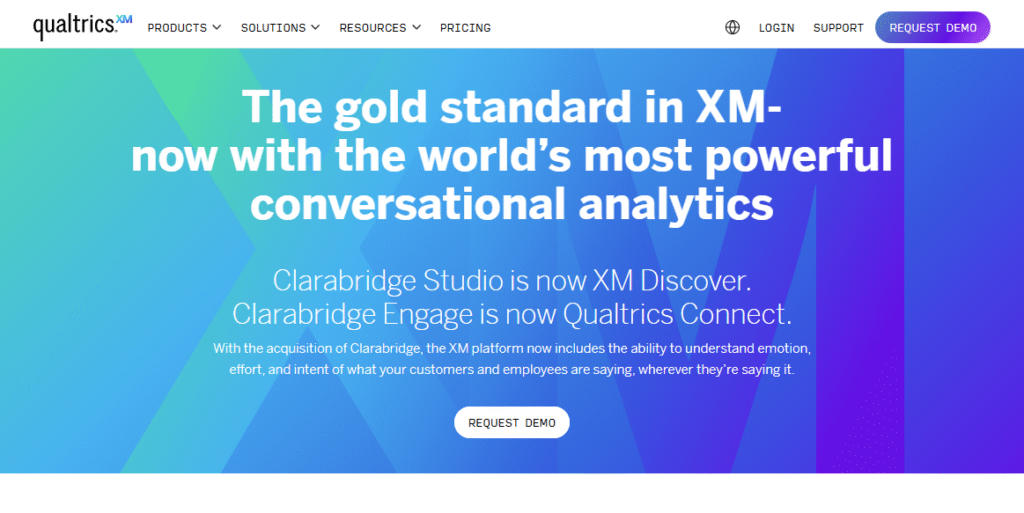
Clarabridge (recently acquired by Qualtrics) is one of the most advanced VoC platforms for text and speech analytics. It’s designed for enterprises handling large volumes of unstructured feedback such as call transcripts, chat logs, and social media comments. In Clarabridge reviews, businesses often highlight its natural language processing (NLP) accuracy and ability to extract insights from complex datasets that traditional survey platforms can’t process.
Key Features
Text & Speech Analytics
Clarabridge analyzes unstructured data from customer service calls, reviews, chats, and emails. It uses NLP to categorize topics, detect emotions, and uncover recurring issues at scale.
Multi-Language Sentiment Analysis
With support for dozens of languages, Clarabridge enables global brands to analyze customer sentiment worldwide, ensuring insights are accurate across diverse markets.
Omnichannel Feedback Integration
The platform pulls in feedback from surveys, social platforms, emails, and contact centers. This unified view gives businesses a robust understanding of customer sentiment across channels.
Role-Based Dashboards
Executives, managers, and frontline teams can each access dashboards customised to their needs, ensuring insights are relevant and actionable at every level.
Compliance & Security
Clarabridge is built for enterprise use cases where data security and compliance (e.g., GDPR, HIPAA) are critical. This makes it popular in industries like healthcare, finance, and telecom.
Pros & Cons
| Pros | Cons |
| Industry-leading NLP accuracy | Pricing is enterprise-only |
| Handles massive unstructured datasets | Steep learning curve |
| Multi-language sentiment detection | Not suitable for SMBs |
| Strong in call center analytics | Requires dedicated implementation |
| Role-based dashboards for teams | More complex than survey-first platforms |
Pricing
Clarabridge operates on a custom enterprise pricing model, typically in the mid-to-high six figures annually for large deployments.
Best For Enterprises Handling Complex Feedback
Clarabridge is best suited for:
- Call Centers & Telecoms — analyzing millions of support interactions.
- Financial Services — detecting customer frustration across multiple touchpoints.
- Healthcare Providers — monitoring patient experience while staying compliant.
- Global Brands — analyzing sentiment across multiple languages and regions.
- Executives — requiring AI insights for board-level strategy.
Pair Clarabridge’s speech analytics with call center coaching programs. By identifying recurring frustration triggers in calls, managers can train agents more effectively.
How to Use Clarabridge for Social Media Monitoring
Integrate social listening into Clarabridge to track sentiment about your brand in real time. This helps identify potential PR crises early and allows for faster brand reputation management.
Best Alternate Tool
If you need advanced analytics but at a more accessible level, InMoment is a strong alternative. It provides predictive insights and sentiment analysis without requiring the same enterprise-level investment.
13. Alchemer (formerly SurveyGizmo) – Flexible VoC Surveys with Workflow Power

Alchemer, previously known as SurveyGizmo, is a VoC tool designed for businesses that need more customization than SurveyMonkey or Typeform can provide. Often praised in Alchemer reviews, it combines survey flexibility with workflow automation, making it a strong choice for mid-sized companies that want to embed feedback directly into business processes.
Key Features
Highly Customizable Surveys
Alchemer offers advanced customization options including branching logic, piping, and white-label branding. This gives businesses more control over survey design than most SMB-focused platforms.
Workflow Automation
One of Alchemer’s strongest features is the ability to trigger workflows based on survey responses. For example, a low NPS score can automatically create a ticket in Zendesk or notify a manager in Slack.
Role-Based Reporting
Dashboards can be customized for different teams, ensuring executives see strategic trends while frontline staff receive actionable insights.
Multi-Channel Distribution
Surveys can be sent via email, embedded on websites, or shared through QR codes. Alchemer also supports offline surveys, useful for trade shows or field research.
Integrations & API Access
The platform integrates with HubSpot, Salesforce, Jira, and other key business systems. Advanced users can take advantage of the API for even deeper customization.
Pros & Cons
| Pros | Cons |
| Extremely customizable surveys | More complex than entry-level tools |
| Workflow automation saves time | Can feel overwhelming for small teams |
| Great integration ecosystem | Higher learning curve |
| Role-based dashboards | More expensive than SurveyMonkey |
| Supports offline surveys | Analytics less advanced than Qualtrics |
Pricing
Alchemer pricing starts at $49/month for basic plans, with professional and enterprise packages available at higher tiers. Custom pricing is available for organizations with advanced needs.
Best For Mid-Sized Businesses Needing Flexibility
Alchemer is best suited for:
- Mid-Market Companies — requiring flexibility without enterprise-level costs.
- Agencies — running customized client feedback campaigns.
- Product Teams — integrating customer insights into development workflows.
- CX Leaders — who want survey responses tied to workflows.
- Field Research Teams — collecting offline feedback at events.
Use Alchemer’s automation workflows to instantly escalate negative survey responses. This ensures no dissatisfied customer slips through the cracks.
How to Use Alchemer for Customer Success Teams
Set up automated workflows that notify account managers when NPS or CSAT scores fall below a set threshold. This allows customer success teams to act before accounts churn.
Best Alternate Tool
If you prefer a simpler option with strong survey design but less workflow power, Typeform is a good alternative. Its conversational interface often leads to higher response rates.
14. Yotpo – VoC and Reviews for eCommerce

Yotpo is a VoC platform built specifically for eCommerce businesses. It focuses on customer reviews, ratings, and user-generated content to help online stores increase trust and sales. In many Yotpo reviews, businesses highlight how it integrates reviews with loyalty programs and marketing automation, making it a powerful all-in-one solution for online retail.
Key Features
Review & Rating Collection
Yotpo makes it easy to collect and display customer reviews and ratings on product pages, boosting conversion rates by leveraging social proof.
Visual User-Generated Content (UGC)
Customers can upload photos and videos with their reviews. This user-generated content increases engagement and adds authenticity to product listings.
Loyalty & Referral Programs
Yotpo allows brands to run customer loyalty programs and referral campaigns directly in the platform, turning satisfied customers into repeat buyers and advocates.
SMS & Email Marketing Integration
The platform integrates with marketing tools to send automated review requests and feedback prompts via email and SMS, ensuring higher participation rates.
eCommerce Integrations
Yotpo connects seamlessly with Shopify, Magento, WooCommerce, BigCommerce, and Salesforce Commerce Cloud, making it one of the most eCommerce-friendly VoC tools available.
Pros & Cons
| Pros | Cons |
| Strong eCommerce integrations | Can get expensive for advanced plans |
| Combines VoC with loyalty features | Less useful for non-retail industries |
| UGC boosts product trust | Complex setup for first-time users |
| Helps increase sales directly | Reporting not as advanced as Qualtrics |
| Supports SMS review requests | Some features locked behind higher tiers |
Pricing
Yotpo pricing starts at $19/month for basic review collection. More advanced features like loyalty programs and SMS marketing are available in higher-tier plans or custom enterprise packages.
Best For eCommerce Brands Leveraging Customer Voices
Yotpo is best suited for:
- Shopify & WooCommerce Stores — adding product reviews quickly.
- D2C Brands — building loyalty programs alongside VoC.
- Retailers — using UGC to increase conversions.
- Small Online Shops — starting with affordable review collection.
- Enterprises — managing reviews across large product catalogs.
Pair Yotpo’s review requests via SMS with post-purchase campaigns. Customers are more likely to respond to mobile prompts than email, especially for quick reviews.
How to Use Yotpo for UGC Marketing
Encourage customers to upload product photos with reviews. Feature these on social media or product pages to create authentic content that drives higher engagement.
Best Alternate Tool
If you’re looking for broader reputation management across multiple channels (not just eCommerce), Birdeye is a stronger alternative. It focuses on multi-location businesses and online review aggregation.
15. Podium – Customer Messaging and Reviews for Local Businesses
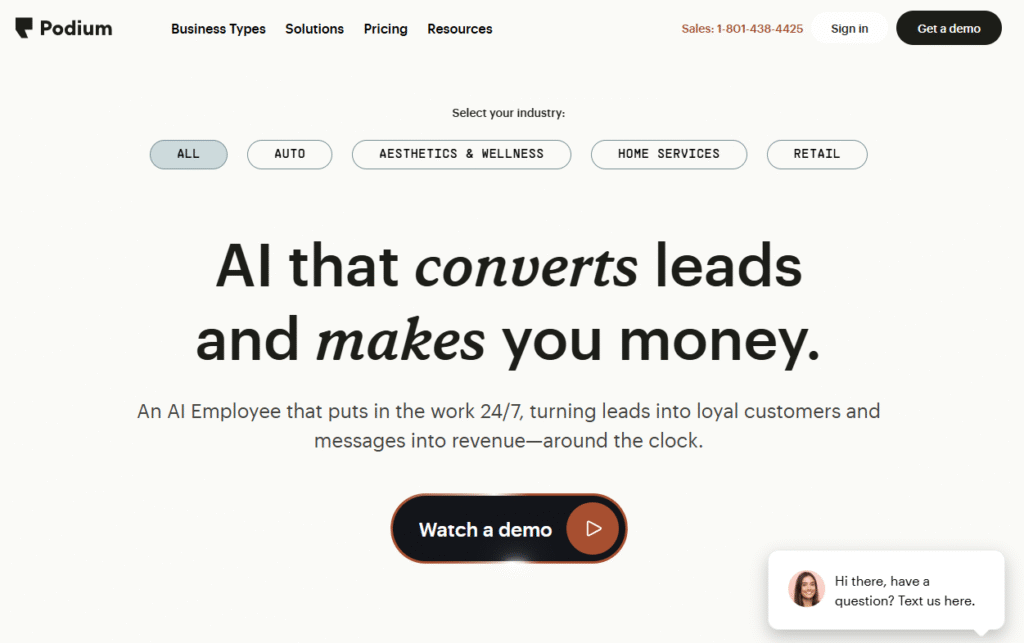
Podium is a VoC platform customised for local businesses and service providers. It specializes in messaging, online reviews, and payment collection, making it a favorite among dentists, auto shops, real estate agencies, and other small-to-mid-sized service companies. In Podium reviews, users consistently highlight its strength in helping businesses collect more Google reviews and engage customers through SMS.
Key Features
Review Collection
Podium simplifies the process of asking customers for reviews on Google, Facebook, and industry-specific platforms. This directly improves online visibility and local SEO rankings.
Business Messaging
Podium centralizes customer communication by bringing together SMS, Facebook Messenger, Google Messages, and website chat into one inbox. This helps local businesses respond faster and more effectively.
Payments via Messaging
Customers can pay invoices through text messages, reducing friction and speeding up transactions. This feature is particularly helpful for service providers.
Customer Feedback Surveys
Podium enables businesses to send short, mobile-friendly surveys to capture sentiment right after service interactions.
Integration Ecosystem
Podium integrates with tools like QuickBooks, Salesforce, and dozens of industry-specific software solutions, making it adaptable to different business models.
Pros & Cons
| Pros | Cons |
| Excellent for local businesses | Pricing is higher than SMB survey tools |
| Strong Google review collection | Limited advanced VoC analytics |
| Centralized messaging inbox | Focused mainly on service industries |
| SMS payments improve convenience | May be overkill for small solo operators |
| Boosts local SEO | Not built for enterprise-wide CX programs |
Pricing
Podium pricing starts at $249/month, with higher-tier plans available for businesses needing more advanced features and integrations.
Best For Local Businesses Focusing on Reviews and Messaging
Podium is best suited for:
- Service Providers — such as dentists, auto repair shops, and salons.
- Local Retailers — boosting visibility with Google reviews.
- Real Estate Agents — centralizing customer communications.
- Healthcare Practices — capturing patient feedback via SMS.
- Multi-Location Franchises — managing reviews across locations.
Use Podium’s automated review requests immediately after a positive service interaction. Timing is critical—customers are far more likely to leave a review while the experience is fresh.
How to Use Podium for Local SEO
By automating Google review collection, Podium helps local businesses climb search rankings faster. Consistent positive reviews increase click-through rates from Google Maps and local search results.
Best Alternate Tool
If your business operates at scale across multiple regions, Birdeye is a stronger alternative. It offers more robust review aggregation and reputation management features for larger operations.
16. Birdeye – Reputation and VoC Platform for Multi-Location Businesses
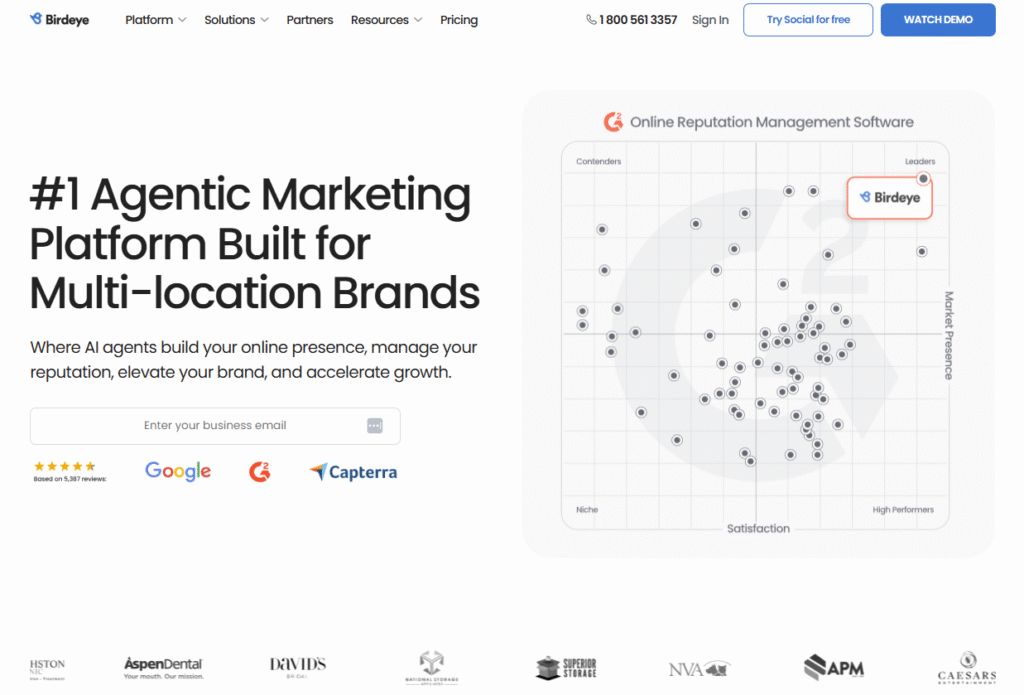
Birdeye is a VoC and reputation management platform designed for businesses that operate across multiple locations. It helps companies collect reviews, manage customer feedback, and improve local SEO performance. In Birdeye reviews, users consistently note how it simplifies managing thousands of reviews and customer interactions from a single dashboard, making it a favorite for franchises and healthcare networks.
Key Features
Centralized Review Management
Birdeye aggregates reviews from Google, Facebook, Yelp, and 150+ other platforms into one interface. This makes it easier to monitor brand reputation across locations.
Multi-Location Dashboard
Enterprises with multiple outlets can track customer sentiment at the individual location level, identifying top performers and locations that need improvement.
Messaging & Surveys
Birdeye offers two-way messaging through SMS and webchat, as well as customizable surveys to capture customer sentiment in real time.
Local SEO Optimization
By helping businesses generate and manage reviews, Birdeye strengthens local search rankings, ensuring each location is more visible to potential customers.
AI-Powered Insights
The platform uses AI to analyze feedback trends, helping businesses detect recurring issues and opportunities for service improvement.
Pros & Cons
| Pros | Cons |
| Great for franchises & multi-location brands | Higher price point for SMBs |
| Aggregates reviews from 150+ sites | Learning curve for full setup |
| Strong local SEO benefits | Custom pricing not transparent |
| AI-powered sentiment analysis | Can feel heavy for single-location businesses |
| Messaging + survey features included | Some advanced features require add-ons |
Pricing
Birdeye pricing starts at $299/month, with enterprise-level plans customized for multi-location rollouts.
Best For Multi-Location Businesses Managing Reputation
Birdeye is best suited for:
- Franchises — managing hundreds of customer touchpoints at scale.
- Healthcare Networks — tracking patient experience across clinics.
- Retail Chains — analyzing location-by-location customer feedback.
- Hospitality Groups — improving guest satisfaction across properties.
- Enterprises — requiring reputation management alongside VoC insights.
Use Birdeye’s location-level reporting to identify top-performing branches. Sharing best practices from high-scoring outlets can quickly raise CX standards company-wide.
How to Use Birdeye for Healthcare Reviews
Healthcare providers can automate post-appointment surveys and review requests. This not only improves patient experience but also strengthens visibility in local healthcare directories and Google search results.
Best Alternate Tool
If you don’t need multi-location management but still want a strong review management platform, Podium is a better fit. It focuses on local service providers and offers more affordable pricing.
17. Reputation.com – Centralized VoC and Reputation Management
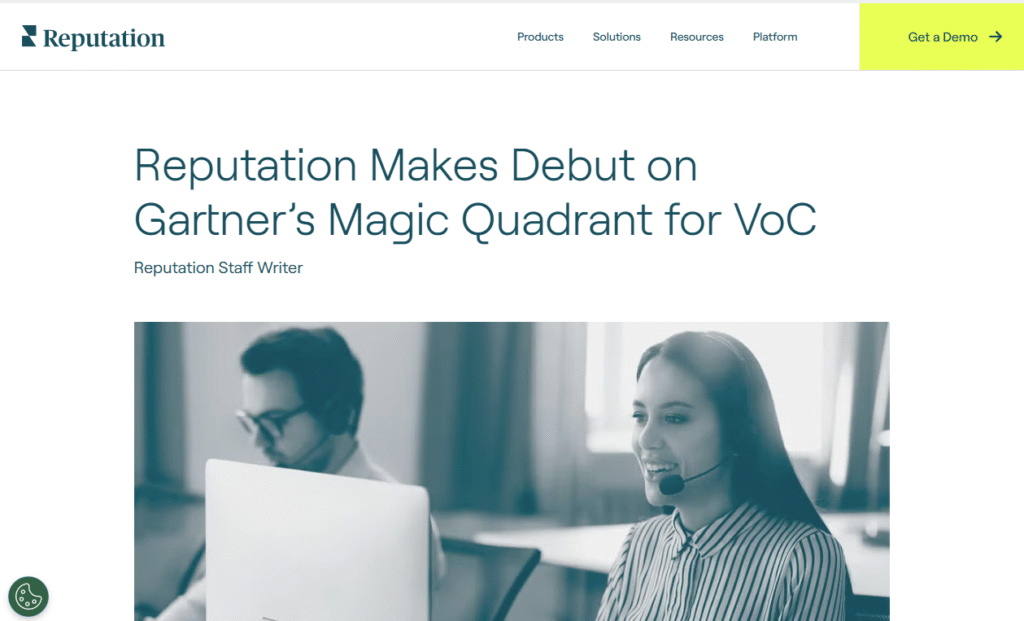
Reputation.com is an enterprise-grade VoC and reputation management platform designed to give organizations a single hub for managing online reviews, customer surveys, and brand sentiment. In Reputation.com reviews, enterprises often highlight its scalability across industries such as automotive, healthcare, and retail. It’s a common choice in Reputation.com vs Birdeye comparisons, with Reputation.com excelling at centralization for very large organizations.
Key Features
Centralized Reputation Dashboard
Reputation.com consolidates reviews, survey results, and social media sentiment into one interface, helping businesses manage their brand image at scale.
Review Generation & Monitoring
The platform automates review requests while monitoring ratings across Google, Yelp, Facebook, and other key platforms. This ensures enterprises never miss critical feedback.
VoC Surveys
Reputation.com includes survey tools to capture NPS, CSAT, and CES feedback. Results feed directly into dashboards for trend analysis.
Competitive Benchmarking
Businesses can compare their performance against competitors in the same industry, helping executives measure CX outcomes in a broader market context.
Advanced Analytics & AI Insights
The platform applies AI-driven sentiment analysis to highlight recurring issues and detect potential risks early, which is essential for brand protection.
Pros & Cons
| Pros | Cons |
| Great for large enterprises | Custom pricing is opaque |
| Strong centralization of reviews | Setup can be complex |
| Benchmarking against competitors | Pricing may be high for SMBs |
| AI-powered sentiment insights | Not as lightweight as SMB tools |
| Industry-specific solutions | Focused more on reputation than product feedback |
Pricing
Reputation.com follows a custom enterprise pricing model, often requiring larger budgets than SMB-oriented platforms like Podium or Birdeye.
Best For Large Enterprises Needing Centralized Reputation Management
Reputation.com is best suited for:
- Automotive Groups — managing dealer reviews across multiple regions.
- Healthcare Systems — tracking patient satisfaction across hospitals.
- Retail Enterprises — unifying feedback from stores nationwide.
- Hospitality Chains — consolidating guest experience insights.
- Executives — who need competitor benchmarking at scale.
Use Reputation.com’s competitive benchmarking to identify not only where your brand underperforms but also where you outperform competitors. Highlight those strengths in marketing campaigns.
How to Use Reputation.com for Automotive Dealerships
Automotive groups can automate review requests after service appointments or vehicle purchases. This strengthens dealership visibility in local searches and provides feedback to improve customer loyalty.
Best Alternate Tool
If your organization has fewer than 50 locations, Birdeye may be a more cost-effective alternative. It offers robust review management and VoC insights without the enterprise-level complexity.
18. Survicate – Agile Surveys for SaaS and Startups
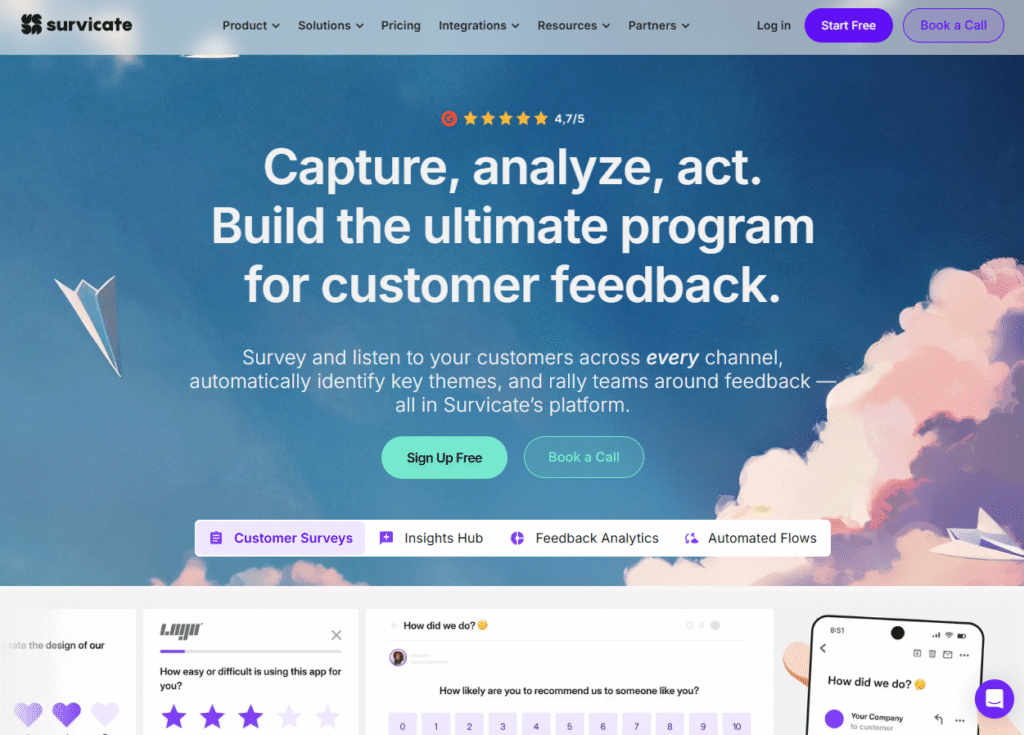
Survicate is a lightweight yet powerful VoC tool designed for SaaS companies, startups, and marketing teams. It focuses on quick survey deployment, especially through website intercepts, mobile apps, and email campaigns. In Survicate reviews, users frequently praise its ease of use and strong integration ecosystem, which makes it a flexible choice for businesses that need customer feedback without the complexity of enterprise platforms.
Key Features
Website Intercept Surveys
Survicate allows you to trigger surveys based on user behavior, such as exit intent, time on site, or specific page views. This provides highly contextual insights.
NPS, CSAT & CES Surveys
The platform comes with templates for standard customer satisfaction surveys, making it easy for teams to measure loyalty and engagement consistently.
Multi-Channel Feedback
Surveys can be distributed across websites, in-app, via email, or through chat integrations. This ensures feedback collection fits seamlessly into customer journeys.
Integrations with CRMs & Marketing Tools
Survicate integrates with HubSpot, Intercom, Salesforce, and Slack, sending survey results directly into existing workflows without manual exports.
Advanced Targeting & Logic
Surveys can be personalized using logic jumps and targeting rules, ensuring only relevant questions are shown to users.
Pros & Cons
| Pros | Cons |
| Great for SaaS and startups | Less powerful for enterprise use |
| Easy to set up and use | Analytics not as advanced as Qualtrics |
| Affordable pricing | Limited offline survey options |
| Strong integrations with marketing tools | Lacks advanced AI insights |
| Flexible targeting and triggers | May require add-ons for scale |
Pricing
Survicate pricing starts at $89/month for small teams, with growth and enterprise packages offering advanced features at higher tiers.
Best For SaaS and Growing Businesses
Survicate is best suited for:
- SaaS Startups — collecting feedback during onboarding and churn events.
- Product Teams — embedding in-app surveys for feature validation.
- Marketing Teams — running website intercept surveys for campaign insights.
- Customer Success Teams — automating NPS surveys via CRM tools.
- SMBs — needing affordable VoC with strong integrations.
Use Survicate’s exit-intent surveys to ask customers why they didn’t convert. This is one of the fastest ways to uncover friction points in your funnel.
How to Use Survicate for SaaS Onboarding
Deploy short in-app surveys during the first week of a new user’s journey. Collecting early feedback helps product managers identify usability issues before churn risks increase.
Best Alternate Tool
If you need stronger predictive analytics alongside surveys, InMoment is a better alternative. It offers more advanced forecasting while Survicate excels at agility and ease of use.
19. Mopinion – Digital Feedback for Websites and Apps
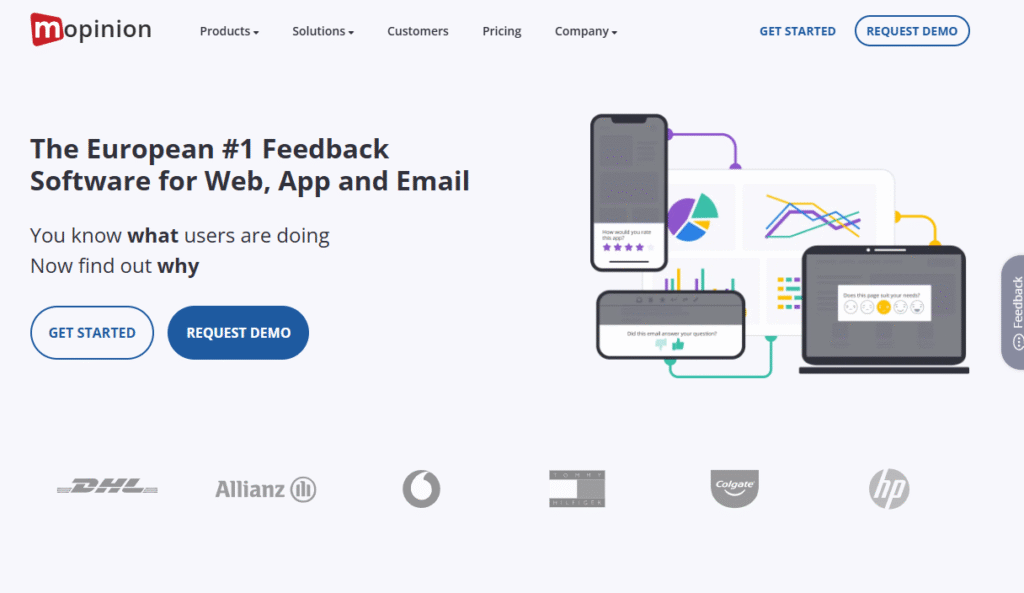
Mopinion is a VoC tool built for digital-first businesses that want to capture customer feedback directly within websites, apps, and email campaigns. It’s widely used by enterprises and SaaS companies that prioritize user experience and conversion optimization. In Mopinion reviews, users highlight its powerful feedback widgets, customizable surveys, and analytics customised for digital teams.
Key Features
On-Site & In-App Feedback Widgets
Mopinion allows businesses to place feedback buttons, pop-ups, and embedded forms inside digital products. Customers can leave feedback while actively engaging, providing more relevant insights.
Real-Time Analytics Dashboard
Responses are visualized in a customizable dashboard with charts, sentiment analysis, and tagging. Teams can quickly spot trends and recurring issues.
Email Feedback Collection
Feedback can be embedded into transactional and marketing emails, allowing brands to capture sentiment post-purchase or after service interactions.
Advanced Targeting & Triggers
Surveys can be shown based on user behavior—like exit intent, cart abandonment, or time spent on a page—making feedback context-driven.
Integrations & APIs
Mopinion integrates with tools like Google Analytics, Jira, Slack, and Salesforce, ensuring VoC data flows seamlessly into daily workflows.
Pros & Cons
| Pros | Cons |
| Great for websites & apps | Higher starting price |
| Strong targeting & triggers | Setup requires some technical effort |
| Centralized feedback dashboard | Not ideal for very small businesses |
| Flexible survey customization | Limited offline feedback options |
| Good integration ecosystem | Enterprise pricing can get expensive |
Pricing
Mopinion pricing starts at $229/month, with enterprise plans available for organizations needing advanced features and multi-channel rollouts.
Best For Digital Teams Optimizing UX and Conversions
Mopinion is best suited for:
- Ecommerce Stores — capturing cart abandonment reasons directly.
- SaaS Companies — collecting feedback during in-app experiences.
- Marketing Teams — embedding surveys in email campaigns.
- UX Researchers — using targeted triggers for contextual insights.
- Enterprises — managing digital feedback across multiple products.
Use Mopinion’s cart abandonment feedback triggers to ask customers why they didn’t complete a purchase. These insights often reveal checkout friction you can fix immediately.
How to Use Mopinion for SaaS Apps
Set up in-app feedback widgets that appear when users access new features. This lets product managers measure satisfaction and adoption quickly.
Best Alternate Tool
If you want a more affordable, SMB-friendly version of on-site surveys, Survicate is a solid alternative. It offers many of the same targeting features at a lower entry price.
20. CustomerGauge – VoC for B2B Enterprises
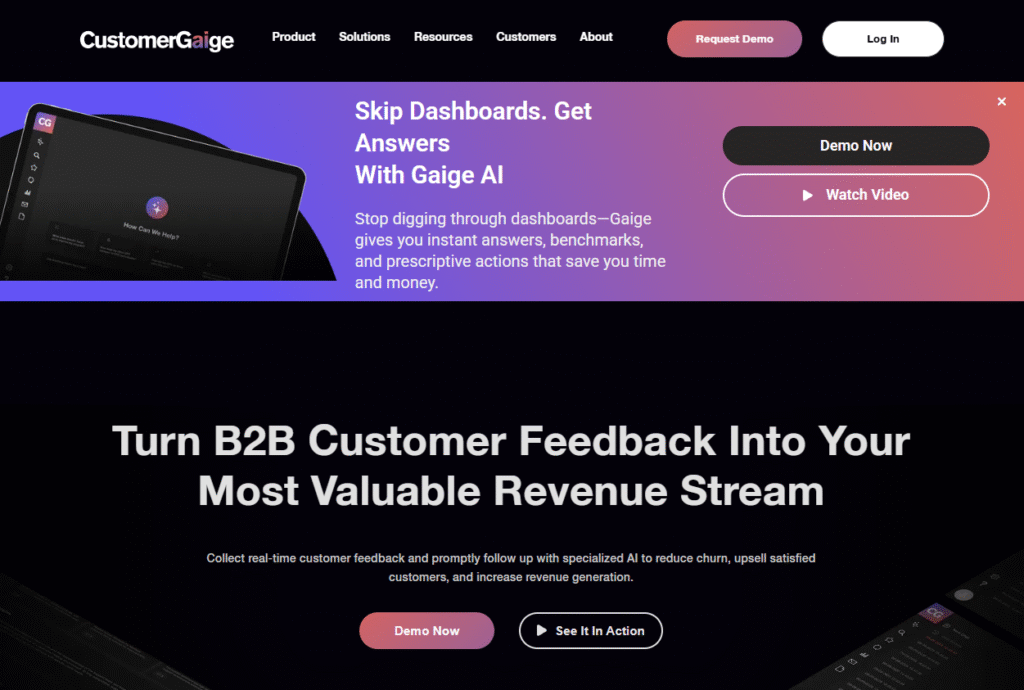
CustomerGauge is a VoC platform built specifically for B2B organizations. Unlike many survey-first platforms, CustomerGauge connects customer feedback directly to revenue data, helping businesses measure the financial impact of customer experience. In CustomerGauge reviews, enterprises often emphasize its strength in account-based feedback and Net Promoter Score (NPS) tracking, making it a top choice in CustomerGauge vs Qualtrics comparisons for B2B scenarios.
Key Features
Account-Level Feedback
CustomerGauge captures feedback at the account level, which is essential for B2B companies managing multiple stakeholders per client. This ensures all decision-makers’ voices are represented.
Revenue-Linked NPS
The platform ties NPS results directly to revenue, helping executives see how customer sentiment correlates with account growth, churn, and expansion opportunities.
Multi-Channel Surveys
CustomerGauge supports surveys via email, web, SMS, and phone, ensuring flexibility across different B2B communication channels.
Closed-Loop Feedback Workflows
Negative responses trigger alerts and follow-up workflows, ensuring at-risk accounts are contacted quickly by account managers.
Reporting & Benchmarking
CustomerGauge provides detailed reporting, including benchmarks that allow enterprises to compare CX performance against other B2B companies.
Pros & Cons
| Pros | Cons |
| Purpose-built for B2B | Expensive compared to SMB tools |
| Revenue-linked NPS insights | Limited appeal for B2C companies |
| Strong closed-loop workflows | Requires training for best use |
| Account-based reporting | Setup can take time |
| Benchmarking for B2B industries | No gamification or lightweight features |
Pricing
CustomerGauge pricing is custom-quoted, typically targeting mid-to-large B2B enterprises with annual contracts.
Best For B2B Enterprises Focused on Account Retention
CustomerGauge is best suited for:
- B2B SaaS Companies — needing account-level NPS tracking.
- Manufacturing Firms — managing complex client relationships.
- Telecoms & IT Providers — handling large enterprise accounts.
- Enterprise Account Managers — connecting feedback to revenue impact.
- Executives — aligning CX metrics with financial performance.
Use CustomerGauge’s revenue-linked NPS to identify at-risk accounts with high contract values. Prioritize those follow-ups first to protect revenue impact.
How to Use CustomerGauge for Expansion Opportunities
Run NPS surveys across existing accounts and segment promoters. Account managers can then target those promoters for upsell and referral campaigns.
Best Alternate Tool
If you’re a smaller B2B company looking for affordability and agility, AskNicely is a solid alternative. It focuses on NPS but is lighter and faster to deploy.
Why These 20 Voice of Customer Tools Matter
Customer expectations are higher than ever, and companies that ignore customer feedback risk falling behind. The 20 tools we covered—from enterprise giants like Qualtrics and Medallia to SMB-friendly platforms like SurveyMonkey and Podium—give businesses of all sizes the ability to listen, measure, and act on customer sentiment.
Whether your goal is to improve NPS, increase online reviews, or understand customer behavior on digital platforms, the right VoC tool can directly impact retention and revenue.
How Pearl Lemon Experiences Can Power Your VoC Strategy
At Pearl Lemon Experiences, we specialize in helping businesses harness customer feedback to create unforgettable experiences. We don’t just recommend VoC tools—we implement them strategically to align with your goals.
Our team can help you:
- Choose the right VoC platform for your industry and budget.
- Set up surveys, workflows, and dashboards that deliver actionable insights.
- Train your staff to use VoC data effectively.
- Connect customer feedback directly to revenue outcomes.
Ready to take control of your customer experience strategy? Schedule a consultation with our team today and see how we can help you turn customer voices into long-term loyalty.
FAQs
1. What industries benefit most from Voice of Customer tools?
VoC tools are valuable for SaaS, eCommerce, hospitality, healthcare, retail, and service-based businesses. Pearl Lemon Experiences helps adapt them to your industry-specific needs.
2. How can Pearl Lemon Experiences support our VoC implementation?
We work with you to select the right platform, set up workflows, and train your team so customer feedback becomes a practical asset for decision-making.
3. Do you provide VoC consulting for small businesses?
Yes. We help startups and small businesses use tools like Typeform, SurveyMonkey, and Podium to gather insights cost-effectively.
4. Can VoC services improve customer loyalty?
Absolutely. By identifying pain points and acting on customer feedback, businesses can significantly improve retention and repeat purchases.
5. How do you integrate VoC tools with existing systems?
We specialize in connecting platforms like Salesforce, HubSpot, and Zendesk with VoC tools so customer data flows seamlessly into your daily workflows.
6. Do you offer ongoing support after tool setup?
Yes. Pearl Lemon Experiences provides continuous optimization, reporting, and strategy sessions to ensure your VoC program keeps delivering results.
7. What’s the difference between VoC for B2B and B2C companies?
B2B VoC focuses on account-level feedback and revenue linkage, while B2C VoC focuses more on transaction-level surveys, reviews, and experience tracking. We design strategies for both.
8. How quickly can VoC insights show measurable results?
Many businesses see improvements in customer satisfaction and engagement within the first 90 days of implementing a structured VoC program.
9. Can VoC programs improve online reputation?
Yes. By combining review management tools like Birdeye or Podium with surveys, we help businesses strengthen visibility and trust across digital platforms.
10. Why choose Pearl Lemon Experiences for VoC services?
Because we don’t just deploy software—we build a strategy around it. Our focus is on aligning VoC insights with your customer journey and business goals to maximize impact.

